#Train a diffusion model
Explore tagged Tumblr posts
Text
When you spend the time on the commute planning your day in your head, you know it's going to be a long day 😂
Have a nice day everyone 😘

Rule number one, always have your nails match your outfit 💅🏻. 😜
#virtual influencer#ai influencer#ai character#virtual model#ai woman#ai girl#ai hottie#ai generated#stable diffusion#beautiful#train station#nylon pantyhose#nylon tights#nylonlegs#legs#high heel pumps#yellow heels#yellow#Alyssa-AI
153 notes
·
View notes
Text
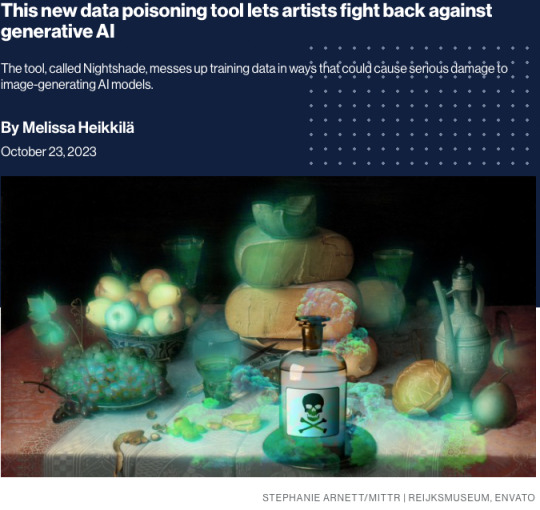
A new tool lets artists add invisible changes to the pixels in their art before they upload it online so that if it’s scraped into an AI training set, it can cause the resulting model to break in chaotic and unpredictable ways.
The tool, called Nightshade, is intended as a way to fight back against AI companies that use artists’ work to train their models without the creator’s permission. Using it to “poison” this training data could damage future iterations of image-generating AI models, such as DALL-E, Midjourney, and Stable Diffusion, by rendering some of their outputs useless—dogs become cats, cars become cows, and so forth. MIT Technology Review got an exclusive preview of the research, which has been submitted for peer review at computer security conference Usenix.
AI companies such as OpenAI, Meta, Google, and Stability AI are facing a slew of lawsuits from artists who claim that their copyrighted material and personal information was scraped without consent or compensation. Ben Zhao, a professor at the University of Chicago, who led the team that created Nightshade, says the hope is that it will help tip the power balance back from AI companies towards artists, by creating a powerful deterrent against disrespecting artists’ copyright and intellectual property. Meta, Google, Stability AI, and OpenAI did not respond to MIT Technology Review��s request for comment on how they might respond.
Zhao’s team also developed Glaze, a tool that allows artists to “mask” their own personal style to prevent it from being scraped by AI companies. It works in a similar way to Nightshade: by changing the pixels of images in subtle ways that are invisible to the human eye but manipulate machine-learning models to interpret the image as something different from what it actually shows.
Continue reading article here
#Ben Zhao and his team are absolute heroes#artificial intelligence#plagiarism software#more rambles#glaze#nightshade#ai theft#art theft#gleeful dancing
22K notes
·
View notes
Text
There is no such thing as AI.
How to help the non technical and less online people in your life navigate the latest techbro grift.
I've seen other people say stuff to this effect but it's worth reiterating. Today in class, my professor was talking about a news article where a celebrity's likeness was used in an ai image without their permission. Then she mentioned a guest lecture about how AI is going to help finance professionals. Then I pointed out, those two things aren't really related.
The term AI is being used to obfuscate details about multiple semi-related technologies.
Traditionally in sci-fi, AI means artificial general intelligence like Data from star trek, or the terminator. This, I shouldn't need to say, doesn't exist. Techbros use the term AI to trick investors into funding their projects. It's largely a grift.
What is the term AI being used to obfuscate?
If you want to help the less online and less tech literate people in your life navigate the hype around AI, the best way to do it is to encourage them to change their language around AI topics.
By calling these technologies what they really are, and encouraging the people around us to know the real names, we can help lift the veil, kill the hype, and keep people safe from scams. Here are some starting points, which I am just pulling from Wikipedia. I'd highly encourage you to do your own research.
Machine learning (ML): is an umbrella term for solving problems for which development of algorithms by human programmers would be cost-prohibitive, and instead the problems are solved by helping machines "discover" their "own" algorithms, without needing to be explicitly told what to do by any human-developed algorithms. (This is the basis of most technologically people call AI)
Language model: (LM or LLM) is a probabilistic model of a natural language that can generate probabilities of a series of words, based on text corpora in one or multiple languages it was trained on. (This would be your ChatGPT.)
Generative adversarial network (GAN): is a class of machine learning framework and a prominent framework for approaching generative AI. In a GAN, two neural networks contest with each other in the form of a zero-sum game, where one agent's gain is another agent's loss. (This is the source of some AI images and deepfakes.)
Diffusion Models: Models that generate the probability distribution of a given dataset. In image generation, a neural network is trained to denoise images with added gaussian noise by learning to remove the noise. After the training is complete, it can then be used for image generation by starting with a random noise image and denoise that. (This is the more common technology behind AI images, including Dall-E and Stable Diffusion. I added this one to the post after as it was brought to my attention it is now more common than GANs.)
I know these terms are more technical, but they are also more accurate, and they can easily be explained in a way non-technical people can understand. The grifters are using language to give this technology its power, so we can use language to take it's power away and let people see it for what it really is.
12K notes
·
View notes
Text
Anon's explanation:
I’m curious because I see a lot of people claiming to be anti-AI, and in the same post advocating for the use of Glaze and Artshield, which use DiffusionBee and Stable Diffusion, respectively. Glaze creates a noise filter using DiffusionBee; Artshield runs your image through Stable Diffusion and edits it so that it reads as AI-generated. You don’t have to take my work for it. Search for DiffusionBee and Glaze yourself if you have doubts. I’m also curious about machine translation, since Google Translate is trained on the same kinds of data as ChatGPT (social media, etc) and translation work is also skilled creative labor, but people seem to have no qualms about using it. The same goes for text to speech—a lot of the voices people use for it were trained on professional audiobook narration, and voice acting/narration is also skilled creative labor. Basically, I’m curious because people seem to regard these types of gen AI differently than text gen and image gen. Is it because they don’t know? Is it because they don’t think the work it replaces is creative? Is it because of accessibility? (and, if so, why are other types of gen AI not also regarded as accessibility? And even then, it wouldn’t explain the use of Glaze/Artshield)
Additional comments from anon:
I did some digging by infiltrating (lurking in) pro-AI spaces to see how much damage Glaze and other such programs were doing. Unfortunately, it turns out none of those programs deter people from using the ‘protected’ art. In fact, because of how AI training works, they may actually result in better output? Something about adversarial training. It was super disappointing. Nobody in those spaces considers them even a mild deterrent anywhere I looked. Hopefully people can shed some light on the contradictions for me. Even just knowing how widespread their use is would be informative. (I’m not asking about environmental impact as a factor because I read the study everybody cited, and it wasn’t even anti-AI? It was about figuring out the best time of day to train a model to balance solar power vs water use and consumption. And the way they estimated the impact of AI was super weird? They just went with 2020’s data center growth rate as the ‘normal’ growth rate and then any ‘extra’ growth was considered AI. Maybe that’s why it didn’t pass peer review... But since people are still quoting it, that’s another reason for me to wonder why they would use Glaze and Artshield and everything. That’s why running them locally has such heavy GPU requirements and why it takes so long to process an image if you don’t meet the requirements. It’s the same electricity/water cost as generating any other AI image.)
–
We ask your questions anonymously so you don’t have to! Submissions are open on the 1st and 15th of the month.
#polls#incognito polls#anonymous#tumblr polls#tumblr users#questions#polls about ethics#submitted april 15#polls about the internet#ai#gen ai#generative ai#ai tools#technology
329 notes
·
View notes
Text
the scale of AI's ecological footprint
standalone version of my response to the following:
"you need soulless art? [...] why should you get to use all that computing power and electricity to produce some shitty AI art? i don’t actually think you’re entitled to consume those resources." "i think we all deserve nice things. [...] AI art is not a nice thing. it doesn’t meaningfully contribute to us thriving and the cost in terms of energy use [...] is too fucking much. none of us can afford to foot the bill." "go watch some tv show or consume some art that already exists. […] you know what’s more environmentally and economically sustainable […]? museums. galleries. being in nature."
you can run free and open source AI art programs on your personal computer, with no internet connection. this doesn't require much more electricity than running a resource-intensive video game on that same computer. i think it's important to consume less. but if you make these arguments about AI, do you apply them to video games too? do you tell Fortnite players to play board games and go to museums instead?
speaking of museums: if you drive 3 miles total to a museum and back home, you have consumed more energy and created more pollution than generating AI images for 24 hours straight (this comes out to roughly 1400 AI images). "being in nature" also involves at least this much driving, usually. i don't think these are more environmentally-conscious alternatives.
obviously, an AI image model costs energy to train in the first place, but take Stable Diffusion v2 as an example: it took 40,000 to 60,000 kWh to train. let's go with the upper bound. if you assume ~125g of CO2 per kWh, that's ~7.5 tons of CO2. to put this into perspective, a single person driving a single car for 12 months emits 4.6 tons of CO2. meanwhile, for example, the creation of a high-budget movie emits 2840 tons of CO2.
is the carbon cost of a single car being driven for 20 months, or 1/378th of a Marvel movie, worth letting anyone with a mid-end computer, anywhere, run free offline software that consumes a gaming session's worth of electricity to produce hundreds of images? i would say yes. in a heartbeat.
even if you see creating AI images as "less soulful" than consuming Marvel/Fortnite content, it's undeniably "more useful" to humanity as a tool. not to mention this usefulness includes reducing the footprint of creating media. AI is more environment-friendly than human labor on digital creative tasks, since it can get a task done with much less computer usage, doesn't commute to work, and doesn't eat.
and speaking of eating, another comparison: if you made an AI image program generate images non-stop for every second of every day for an entire year, you could offset your carbon footprint by… eating 30% less beef and lamb. not pork. not even meat in general. just beef and lamb.
the tech industry is guilty of plenty of horrendous stuff. but when it comes to the individual impact of AI, saying "i don’t actually think you’re entitled to consume those resources. do you need this? is this making you thrive?" to an individual running an AI program for 45 minutes a day per month is equivalent to questioning whether that person is entitled to a single 3 mile car drive once per month or a single meatball's worth of beef once per month. because all of these have the same CO2 footprint.
so yeah. i agree, i think we should drive less, eat less beef, stream less video, consume less. but i don't think we should tell people "stop using AI programs, just watch a TV show, go to a museum, go hiking, etc", for the same reason i wouldn't tell someone "stop playing video games and play board games instead". i don't think this is a productive angle.
(sources and number-crunching under the cut.)
good general resource: GiovanH's article "Is AI eating all the energy?", which highlights the negligible costs of running an AI program, the moderate costs of creating an AI model, and the actual indefensible energy waste coming from specific companies deploying AI irresponsibly.
CO2 emissions from running AI art programs: a) one AI image takes 3 Wh of electricity. b) one AI image takes 1mn in, for example, Midjourney. c) so if you create 1 AI image per minute for 24 hours straight, or for 45 minutes per day for a month, you've consumed 4.3 kWh. d) using the UK electric grid through 2024 as an example, the production of 1 kWh releases 124g of CO2. therefore the production of 4.3 kWh releases 533g (~0.5 kg) of CO2.
CO2 emissions from driving your car: cars in the EU emit 106.4g of CO2 per km. that's 171.19g for 1 mile, or 513g (~0.5 kg) for 3 miles.
costs of training the Stable Diffusion v2 model: quoting GiovanH's article linked in 1. "Generative models go through the same process of training. The Stable Diffusion v2 model was trained on A100 PCIe 40 GB cards running for a combined 200,000 hours, which is a specialized AI GPU that can pull a maximum of 300 W. 300 W for 200,000 hours gives a total energy consumption of 60,000 kWh. This is a high bound that assumes full usage of every chip for the entire period; SD2’s own carbon emission report indicates it likely used significantly less power than this, and other research has shown it can be done for less." at 124g of CO2 per kWh, this comes out to 7440 kg.
CO2 emissions from red meat: a) carbon footprint of eating plenty of red meat, some red meat, only white meat, no meat, and no animal products the difference between a beef/lamb diet and a no-beef-or-lamb diet comes down to 600 kg of CO2 per year. b) Americans consume 42g of beef per day. this doesn't really account for lamb (egads! my math is ruined!) but that's about 1.2 kg per month or 15 kg per year. that single piece of 42g has a 1.65kg CO2 footprint. so our 3 mile drive/4.3 kWh of AI usage have the same carbon footprint as a 12g piece of beef. roughly the size of a meatball [citation needed].
553 notes
·
View notes
Text
Often when I post an AI-neutral or AI-positive take on an anti-AI post I get blocked, so I wanted to make my own post to share my thoughts on "Nightshade", the new adversarial data poisoning attack that the Glaze people have come out with.
I've read the paper and here are my takeaways:
Firstly, this is not necessarily or primarily a tool for artists to "coat" their images like Glaze; in fact, Nightshade works best when applied to sort of carefully selected "archetypal" images, ideally ones that were already generated using generative AI using a prompt for the generic concept to be attacked (which is what the authors did in their paper). Also, the image has to be explicitly paired with a specific text caption optimized to have the most impact, which would make it pretty annoying for individual artists to deploy.
While the intent of Nightshade is to have maximum impact with minimal data poisoning, in order to attack a large model there would have to be many thousands of samples in the training data. Obviously if you have a webpage that you created specifically to host a massive gallery poisoned images, that can be fairly easily blacklisted, so you'd have to have a lot of patience and resources in order to hide these enough so they proliferate into the training datasets of major models.
The main use case for this as suggested by the authors is to protect specific copyrights. The example they use is that of Disney specifically releasing a lot of poisoned images of Mickey Mouse to prevent people generating art of him. As a large company like Disney would be more likely to have the resources to seed Nightshade images at scale, this sounds like the most plausible large scale use case for me, even if web artists could crowdsource some sort of similar generic campaign.
Either way, the optimal use case of "large organization repeatedly using generative AI models to create images, then running through another resource heavy AI model to corrupt them, then hiding them on the open web, to protect specific concepts and copyrights" doesn't sound like the big win for freedom of expression that people are going to pretend it is. This is the case for a lot of discussion around AI and I wish people would stop flagwaving for corporate copyright protections, but whatever.
The panic about AI resource use in terms of power/water is mostly bunk (AI training is done once per large model, and in terms of industrial production processes, using a single airliner flight's worth of carbon output for an industrial model that can then be used indefinitely to do useful work seems like a small fry in comparison to all the other nonsense that humanity wastes power on). However, given that deploying this at scale would be a huge compute sink, it's ironic to see anti-AI activists for that is a talking point hyping this up so much.
In terms of actual attack effectiveness; like Glaze, this once again relies on analysis of the feature space of current public models such as Stable Diffusion. This means that effectiveness is reduced on other models with differing architectures and training sets. However, also like Glaze, it looks like the overall "world feature space" that generative models fit to is generalisable enough that this attack will work across models.
That means that if this does get deployed at scale, it could definitely fuck with a lot of current systems. That said, once again, it'd likely have a bigger effect on indie and open source generation projects than the massive corporate monoliths who are probably working to secure proprietary data sets, like I believe Adobe Firefly did. I don't like how these attacks concentrate the power up.
The generalisation of the attack doesn't mean that this can't be defended against, but it does mean that you'd likely need to invest in bespoke measures; e.g. specifically training a detector on a large dataset of Nightshade poison in order to filter them out, spending more time and labour curating your input dataset, or designing radically different architectures that don't produce a comparably similar virtual feature space. I.e. the effect of this being used at scale wouldn't eliminate "AI art", but it could potentially cause a headache for people all around and limit accessibility for hobbyists (although presumably curated datasets would trickle down eventually).
All in all a bit of a dick move that will make things harder for people in general, but I suppose that's the point, and what people who want to deploy this at scale are aiming for. I suppose with public data scraping that sort of thing is fair game I guess.
Additionally, since making my first reply I've had a look at their website:
Used responsibly, Nightshade can help deter model trainers who disregard copyrights, opt-out lists, and do-not-scrape/robots.txt directives. It does not rely on the kindness of model trainers, but instead associates a small incremental price on each piece of data scraped and trained without authorization. Nightshade's goal is not to break models, but to increase the cost of training on unlicensed data, such that licensing images from their creators becomes a viable alternative.
Once again we see that the intended impact of Nightshade is not to eliminate generative AI but to make it infeasible for models to be created and trained by without a corporate money-bag to pay licensing fees for guaranteed clean data. I generally feel that this focuses power upwards and is overall a bad move. If anything, this sort of model, where only large corporations can create and control AI tools, will do nothing to help counter the economic displacement without worker protection that is the real issue with AI systems deployment, but will exacerbate the problem of the benefits of those systems being more constrained to said large corporations.
Kinda sucks how that gets pushed through by lying to small artists about the importance of copyright law for their own small-scale works (ignoring the fact that processing derived metadata from web images is pretty damn clearly a fair use application).
1K notes
·
View notes
Text
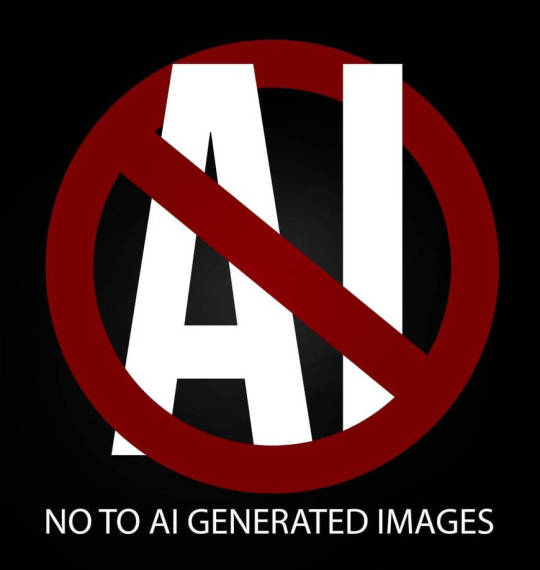
Hiya!
So we all know that AI generators like Midjourney, Stable Diffusion, DALL.E, Sora.AI, etc. have stolen the work from artists online to train their AI and since AI is starting to get quite scary, I've decided I'm going to start protecting my work via Nightshade, but I want to also talk about it with you and link to the official sites to Glaze and Nightshade, so you can get either of these programs to try.
First off, we'll start with Glaze AI.
What Glaze aims to do is to act on the defensive against AI. Glaze will scramble their generators by placing a “protective glaze” over your work, and what this will do, is when your work is fed into the AI, it'll trick the AI into thinking your work is something entirely different from what it is, simply by making small changes that only the AI will pick up on
To quote the official site “Glaze is a system designed to protect human artists by disrupting style mimicry. At a high level, Glaze works by understanding the AI models that are training on human art, and using machine learning algorithms, computing a set of minimal changes to artworks, such that it appears unchanged to human eyes, but appears to AI models like a dramatically different art style.”
I've tried using Glaze, but it's a very big program and my computer can't handle that, but I do highly recommend trying it out if you have the space for it.
If you wanna try it out, the link to the site can be found here.
Second is Nightshade.
Nightshade is aimed to “attack” the AI your work is being fed into. Like Glaze, Nightshade puts a protective “glaze” over your work, but it poisons your work and tricks the AI into messing up the user's prompt.
To quote the official site “Nightshade works similarly as Glaze, but instead of a defense against style mimicry, it is designed as an offense tool to distort feature representations inside generative AI image models. Like Glaze, Nightshade is computed as a multi-objective optimization that minimizes visible changes to the original image. While human eyes see a shaded image that is largely unchanged from the original, the AI model sees a dramatically different composition in the image.”
This program is also pretty big, but it's what my laptop is able to handle, so from here on out I'll be protecting my work with this. I'll also go back and protect my older works even if it's not as appealing as my newer works.
If you wanna try it out, the link to the site can be found here.
Keep in mind, these are only temporary solutions while we wait for more permanent ones.
But even if it's temporary, it's better than having no protection against the AI bros.
#glitch talks#fuck ai art#fuck ai all my homies hate ai#nightshade#glaze#protect your art#ai art is theft
828 notes
·
View notes
Text
In Limbo
simon "ghost" riley x fem!reader | mafia!au | masterlist
Chapter Nine: white light and holly
tw: none

Just as promised, Simon picks you up the following afternoon.
Jack Frost paid you a visit last night, leaving intricate, swirling designs on your windows, obscuring the grey cityscape beyond your apartment in prismatic light. It diffuses your vision to the point that you don’t recognize Simon when he pulls up, and you nearly jump out of your skin when he knocks on the door. Shoulders scrunching, muscles tensing; you turn to the door with a grunt as your cramps jolt through your body. They’re worse today than they were yesterday. They always seem to grow more intense with time. You wish it would remit—but it’s a familiar pain you know how to push through now.
Shouldering on a coat, you open the door only to be immediately scrutinized under Simon’s gaze. Dark eyes flicker over your body, checking for irritated scleras, perspiration, and general fragility. Though you are loads better than when he saw you last week, you’re certain your crossed arms and the slight hunching over your stomach isn’t convincing. Judging by the tight line of his lips, he’s not entirely impressed.
Mustering a smile, you glance behind him, prodding him into action. “Hey. Ready to head out?”
He hums before nodding, boots clomping against the floor as he moves out of the way. “Got the car all warmed up for ya, sweetheart.”
London looks magical around this time of year, especially from the passenger’s seat of Simon’s car. Warm white lights twist up the trunks of every tree, spiraling along branches where stray snowflakes glint in their glory. Evergreen garland adorns street lights with faux holly and winter berries, giving your eyes a break from the otherwise barren concrete jungle. It’s beautiful. Picture perfect. Something you’d expect to see on a postcard or in a movie. The glass of the window fogs up with your breath as you lean closer to get a better look at the streets.
With only one more week until Christmas, the pavement bustles with last minute shoppers. Children in too-large coats and fluffy caps trot behind their parents as they squeal in delight at window displays in flashy shops. The holiday has a way of illuminating everything and casting a warm, yellow glow on the wonderstruck faces peering through the glass. It bathes the streets until they’re lively and buzzing, banishing the gloom of the city—you almost don’t recognize the foreign scene before you.
Once Simon finds a place to park, you’re able to step out into that wonderland yourself. A soft breeze nips at the tips of your ears and nose, rubbing them raw with crystalline shards like sandpaper across your skin, but you ignore it in favor of the toy shop display flashing through the window. A model train travels through a tiny village dusted with synthetic snow. Tiny villagers go about their tiny lives as they attend church and visit family or throw snowballs at one another. Each of them are hand painted with care—complete with rosy cheeks and colorful winter attire.
Simon’s reflection dances in the glass as he approaches your side, looking down at the scene you can’t help but gawk at. His arm brushes against yours as he inspects the paintwork on the figurines, and you glance at him with a smile. His face glows in the light, bringing his skin to life, scars and all. It casts shadows on his face perfectly, defining the curve of his jaw and his cheekbones.
You can’t help but swallow as he rubs his chin, and you force your attention back on the model village before you. “I wish it would snow more in London.”
He hums, feet shuffling on the pavement. “Would be a lot of shoveling.”
“Well, it wouldn’t have to snow a whole lot,” you chuckle. “Just enough to stick around. Thick enough to make snow angels out of.”
You pause to watch the train travel through the tunnel. A small light fixed to the front of the locomotive cuts through the darkness, and you watch it grow brighter as it nears the exit. In your head, you can imagine its whistle and the huff and puff of smoke as the engine burns coal to transport presents just in time for Christmas Day.
“My dad and I used to make frost angels instead. The grass at the park would always glisten with frost, especially in the mornings, so we’d lay in the field and make angels.” You laugh at the memory as a fit of giggles erupts behind you. A small group of siblings pass by with toys in hand. For a moment, you almost feel warm. “They never looked really pretty, but he’d always finish them off with halos anyway.”
“Could always blend up some ice for ya,” Simon patronizes.
You mock laugh at him. “Oh sure, thanks. Think you can get all of London covered by Christmas?”
He shrugs. “Anything for you, sweetheart.”
Ignoring the way your palms begin to sweat, you quickly change the subject, suggesting that you get to shopping before you freeze to death. Thankfully, Simon bites and leads you inside of the toy shop where you’re welcomed by a jovial clerk with a kind smile. A green elf hat sits on his head, leaving the children nearby to gawk and titter. Christmas music plays softly through the radio on the back counter, and it fades in and out as you wander between shelves where spiced cinnamon and pumpkin wafts in a trail behind you.
A variety of toys adorn the aisles, but Simon appears to be on a mission for something in specific. He completely bypasses the frilly princess costumes, fancy dolls, action figures, and craft supplies in favor of toy cars and model ships. They’re cute; impossibly small. Made perfectly for little hands and fingers.
Then, you make the mistake of looking at the price tags.
There’s a special aesthetic that surrounds this time of year. Something beautiful and kind. It lurks in incandescent light bulbs and wrapping paper. It tops gingerbread cookies and their matching homes. There’s a mawkish joy that tugs at your heart and leaves your stomach churning beneath your diaphragm as an orchestral version of Jingle Bells blares on the speakers overhead.
Despite it all, there’s always going to be something that will separate you from everyone else. You’ll never be the one bringing home gifts to family members. Never be the one to splurge on a desperately wanted present. Each year you can hardly scrounge up enough to give Aelin something. Hell, you’re not even sure if you’ll have enough to buy the sanitary products you so desperately need.
“What kind of present are you looking for?” Push it out of your mind. You can’t mope forever.
“Somethin’ my nephew’s been wantin’ for a bit. He’s been talkin’ his parents ear off ‘bout it for the last few months,” Simon replies, eyes scanning the shelf in front of him. He hums as his fingers ghost over the box of a model plane. “Been obsessed with planes lately.”
“Nephew?” you repeat. “So, you have siblings then?”
“A brother. Thomas. Everyone calls ‘im Tommy. I like to call him a pain in the arse,” he humors.
Chuckling, you crouch down to assist Simon’s search for the perfect gift. This movement—curling in on yourself—temporarily eases the cramps that still fester deep in your abdomen, and you sigh. No matter how little the reprieve is, it’s always welcome.
“Big or little brother, then?” you ask.
“Older. Certainly isn’t bigger than me.”
“Yeah, figure it’s pretty hard to be bigger than you.”
Falling quiet, you put in more effort into searching through eye-catching toys flashy enough to steal away any child’s attention. They’ve got everything from small sets made out of metal, to build-your-own models. It’s certainly fancier than anything you remembered from when you were a kid.
“Oh! This is cute,” you coo.
Your hands reach out for a large box padded with smooth cardboard. For its size, it’s incredibly light, so it’s easy work to slide it off of the shelf. A precious, design-it-yourself RC plane, complete with paint and all. The box depicts what you assume is supposed to be a father and his son painting designs on the body of the plane together.
You hold the box up for Simon to see, giving it a little shake. “Look, he could design his own little plane!”
Simon’s eyes widen in recognition as you straighten yourself out, box still in hand. “That’s the one.”
Holding it out for him to take, he relieves you of it. Large hands dwarf the box as he flips it around, reading the description on the back. He smirks, then chuckles before shaking his head.
“As seen on TV,” he quotes. “They play the commercial for this between his favorite cartoons. Been begging his mum for it ever since.”
“What’s his name?” you ask.
“Joseph.”
Before you have the chance to comment further, Simon slides the box underneath his arm while his free hand retrieves his phone. The screen flickers on, casting a dim glow on his face as he clicks through applications.
When he turns it in your direction, you’re met with a half fuzzy photo of a young boy and a woman. They’re outside, sitting in a pile of leaves, their dying colors of red and yellows vibrantly declaring the autumn season. A few torn leaves stick to the boy’s bright blonde hair as he attempts to shove a fistful of them into the woman’s hair. They don’t quite stick to her copper locks, but she grins at him anyway. With bright blue eyes and beautiful smiles, they’re near carbon copies of one another.
“Tom sent me this a few months back. That’s little Joey there, and his mum, Beth,” Simon shares.
“He’s adorable,” you coo. “How old is he?”
The very moment Simon answers, an unforgiving contraction rips through your abdomen. Muscles cramp and tighten, pulling so taut you fear they’ll tear each other apart. In a pitiful attempt to soothe yourself, your hand presses right above where your uterus is wreaking havoc on your body. With enough pressure, you’re sure you can phase through your organs and reach into yourself to remove the nuisance straight from the source. Instead, you fight back a grimace as you feel your organs collapse in on one another.
No matter how hard you try, you’re unable to hide such vicious pain from Simon. He catches on quickly. Sniffs it out like a cadaver dog. His phone shuts off yet stays firmly in his palm as he presses the back of his hand against your forehead. Taken aback, you stare up at him, mouth trying to form words, yet nothing falls from your lips. There’s something about this touch that feels familiar. Something that leaves you feeling empty when he moves his hand away.
“Sure you’re feelin’ alright?” he asks. “Still a little warm. Don’t look like you’re feelin’ too good, sweetheart.”
Maybe it’s due to what your body has been going through as of late, or maybe it’s because of the way he’s looking at you, but your mouth grows dry. Like a desert. Devoid of the oasis of words you so desperately need. There’s no use in beating around the bush—or at least you try to tell yourself as much—you’ve followed him out here for a reason.
“Yeah, I’m just… you know. On my menses,” you explain, trying to make it sound humorous, but it comes off as more awkward than anything. “That’s, uh, one of the reasons I came with you today. Was sorta hoping I could drop by the pharmacy to pick some stuff up.”
You hoped the concern etched into his face would melt away with your explanation, but if anything it only gets worse. “You shoulda said something. Would’ve dropped by there first.”
“It’s no big deal,” you attempt to assure. “I mean, it’s not like this stuff goes away with a magic medication or something.”
God, you wish it would. A simple pop of a pill and a quick nap to have this all fade away sounds heavenly. It would save you from the odd look Simon gives you as he shoves his phone back into his pocket. For a moment, you wonder if you’ve made him uncomfortable. Some men get… squeamish around this type of talk. You have a very vivid memory shoved in the back of your mind of one of the cooks getting on Bee for walking in the restaurant with a box of tampons in hand. She told them off with a bravery you can only dream of mustering. They have yet to mention anything since, but the image of their tense faces is forever burned into your mind.
You wonder if it’s the blood or the body it comes from that disgusts them so much.
“C’mon,” Simon urges as he nods towards the end of the aisle. “Should be a pharmacy on the end of the block.”
“But what about presents for your family?” you ask.
“This was the last thing I was lookin’ for. Everythin’ else is already covered,” he assures you. “We’ll go up to pay then get you what you need, yeah?”
If there’s one thing you’ve learned about Simon Riley over the last few months, it’s that he’s a force to be reckoned with. Of course, you’ve known this fairly early on. He’s the apotheosis of strength. You felt it from the way his hands held yours when he taught you how to shoot pool, how firm and unwavering they were against yours. It’s a force that evolves. One moment it’s as soft as a whisper, and the next it’s sharp enough to send a man as terrifying as Andrei whimpering and running for the hills.
You wonder if he brings that same heat to Terminus. Doing grunt work in the club, fighting off men gathering around the innocent like flies drawn to rot and decay. How often have those teeth been redirected at him, causing the puffy scars that trace the features of his nose and jaw? Are his claws only razors because someone else sharpened them for him?
Too many times have you seen men like Simon deteriorate. They shatter; fracture into warped reflection of themselves as they become nothing but self-centered beasts who don’t fear spilling blood. Strength and power corrupts even the kindest of people—turns humans into monsters; into men like Marco.
Simon should terrify you, but he doesn’t.
You don’t fully realize why that is until you reach the pharmacy.
Even with your obvious apprehension about him accompanying you inside, he does anyway. Simon trots behind you like an obedient dog as you weave through aisles with your eyes trained on each item you come across. He doesn’t flinch at the hygiene products. Instead, he watches intently as you peruse, counting numbers in your head and quids in your hand. It’s this counting game again. Barely scraping by—not having enough to buy supplies that will last you more than a few days, forever stuck with travel sized versions of what you require.
When he catches that disconsolate expression on your face, he insists on paying for you.
“I’m not gonna let you go without what’cha need. These prices are robbin’ you blind,” he says when you try to argue.
“You shouldn’t have to do this,” you retort, guilt eating you alive.
“I’m not buyin’ you a pony here, sweetheart. They’re pads and tampons. Necessities.”
Stubborn as an ox, he doesn’t budge. Simon is persevering, and certainly has more stamina to argue than you do. Saving yourself from any further embarrassment, you finally allow it. You keep a mental note to remind yourself to buy him something when you get the money.
If you get the money.
Bundled up in his arms, Simon carries the items up to the counter himself, even going as far as to sneak some over the counter painkillers in the process. You follow behind him like a wounded animal; or, at least the clerk looks at you as if you are one. A wet stray cat. A fox caught in a trap. Some pathetic, bleeding bitch—it’s like he can smell the blood that stains the insides of your thighs. Shame mixes with the embarrassment coursing through your veins, lighting you on fire until you’re nothing but a boiling mess of a woman.
Suddenly, the only thing you see is Simon’s back.
“Get paid to stare, or are you gonna ring us up?” he grunts.
Simon cares ferociously, you realize. Unabashedly an altruist. That’s why you’re not scared of him. It would be so easy for him to take—to scrape up everything he wants and shove it into his pocket like it’s always belonged to him—but he doesn’t. Simon likes balance. Enjoys peace. When he snarls, it’s done with sharp teeth; just enough to get the glares and smirks to dissipate, and when he looks back at you, they’re dull. He doesn’t speak about the tally. There are no numbers written in the back of his mind. No debt to pay.
He doesn’t keep count. Simon cares because that’s what he wants to do, and if it’s not, then he is the greatest pretender you have ever met.
You’re only able to breathe again when you’re back in Simon’s car with your seatbelt fastened and menstruation supplies are in hand. Dusk settles in the sky with a soft lilac hue as you’re taken back home, but the streets refuse to darken. Christmas joy bathes the pavement, illuminating the concrete with bright lights that diffuse dreamily through the car window—they almost look like stars. You squint and try to pick out a constellation—it makes a good distraction for the cramping and humiliation that festers in your stomach.
“Got plans for Christmas?”
Neither of you have spoken in so long that you nearly jump at the warm baritone resonating in his chest. Glancing at Simon, you quell your heart as you watch him for a moment. Hands carefully on the wheel, safely maneuvering through traffic—your stomach drops.
“Oh, uhm, not really. Usually I spend it with John and Aelin, but they’re headed out of the country for the holiday. My parents passed when I was a kid, so… uh, otherwise I think I’ll probably spend it at home? Relax, or whatever,” you explain.
An eternity passes by as you wait for his response. As the engine hums and the radio plays old Christmas tunes, you feel his words before they even form on his tongue. You try not to grimace before the words leave his mouth.
“I’ve got family in Manchester. My mum’s hostin’ my brother and I for the holiday. You’re more than welcome to join, if you’d like,” he offers.
Your eyes flutter as you look at your hands with a sigh. “You know you don’t… have to do all that, right?” you ask.
“Do what?” he questions, sincere confusion lacing his tone.
“I know that Aelin asked you to keep an eye on me, and that she’s concerned about me, or whatever; and I can’t thank you enough for everything you’ve done for me, truly. But Simon, this is your family. I can’t… barge in. You deserve to spend time with them without having to worry about, you know… me.”
His head shakes, eyes daring a glance at you as you fiddle with the bag in your lap. “Mrs. Price isn’t makin’ me do anything. And you’re not bargain’ in if I invite you,” he says.
Teeth digging into the flesh of your bottom lip, you feel yourself sunder. Long, spiderweb cracks form in your foundation as your heart pounds so hard you fear it’ll rip itself to shreds. You’re becoming undone in the passenger’s seat of a car, and you swear this time it will be the end of you.
“Sweetheart,” Simon prompts softly, “I’m not askin’ you because of Aelin, or anyone else. She didn’t even mention it to me, I swear it. I’m askin’ because I want to know if you’ll go to Manchester with me. That’s it.”
Finally, you bring yourself to look at him as anxiety slithers down your throat when you swallow. “Do you… really want me to go?”
“Course I do. Wouldn’t be askin’ if I didn’t. I’d be chuffed if you did, but it’s up to you.” He pauses as he spares another glance at you. “You can say no.”
Quiet eudaimonia warms your chest at his words, but you’re not sure which part has done you in. Is it his outspoken wish that he wants you to join him? That it would make him happy if you came along? Or is it his quiet reminder that—despite his desires—you still have a choice?
“When would we leave?” you ask.
“Christmas Eve, most likely. Still got work up until then, and we’d have to be back the day after Christmas. It’d be a short trip,” he explains.
Lungs filling with air, your heart settles as you manage a quiet smile. “Okay. Well… I’d love to meet them. Your family. It would be… nice not to be alone this Christmas.”
Simon smiles, and you find yourself staring at him longer than you should. If he notices, he doesn’t say anything. He is really… handsome. Ruggedness, scars, crooked nose and all—his features come together perfectly as if sculpted by an artist. This is the same man who fought off a blade for you, the man who’s assured you were safe on several occasions, who refuses to be bashful or stationary when it comes to ensuring your comfort. This is the man who always walks you up the stairs to your apartment, refusing to let you out of his sight until he knows you’re safe in your residence. The man who fixed your door, your sink—
—everything.
As you say goodnight and reiterate your plans for Christmas, your mind repeats that phrase: Simon Riley cares ferociously.
Simon Riley cares ferociously about you.
It continues. Repetitive. Never-ending. It doesn’t cease. Not even as Simon vanishes back down the stairs and you shut and lock the door behind him. Not even when you toss yourself face first into your bed, period products discarded on some forgotten counter in your kitchen. Fervid desire swells in your chest to the point you feel your ribs and cartilage threaten to pop. You’ll explode into a mess of viscera until you're unrecognizable, and it hurts. It hurts but feels like the closest thing to freedom that you’ve tasted in a long time.
For the first time in ages, something finally feels like it’s changing for the better.
When your phone rings an hour later, you find yourself looking at the screen hoping it’s Simon. You drop everything, pasta nearly over boiling on the stove, just to fetch the device. Your stomach plummets through the floor when you see Aelin’s caller ID instead of his, and then you’re struck with guilt. A palpable tension still stretches between the two of you since your last conversation. You still taste the bile—that stomach acid and soup.
Your hand shakes as you press accept and turn the heat down on the burner. “Hello?”
“Hey,” Aelin greets. Her voice is pillowy. Careful. “You sound better than you did last week.”
“Yeah, feeling a lot better,” you admit. Your laugh is awkward. Tense. It’s as if you’re talking to a stranger, and maybe in some way you are. That’s what you’ve been doing, isn’t it? Pushing her away, building walls until you're unrecognizable to one another. Nothing but strangers who have known each other for half your lives.
“Good. That’s good. Hey, uhm…” You brace yourself, eyes shutting as you let steam from the pot brush over your face as she continues. “I wanted to apologize for last week. For… honestly the last few weeks. You’ve been going through a rough time with work and everything and… and what I thought was me being supportive or helpful was really just me being a dunce. When I see something I think is a problem, I want to fix it right away, and when I can’t I get so frustrated and… well, I shouldn’t have said what I said to you the other day. That wasn’t fair to you at all.”
Aelin pauses to clear her throat, but it still takes her a moment before she speaks up again. When she does, you freeze at the tightness of her voice—it sounds as if her vocal chords are ready to snap. “I just… it makes me sad thinking about you having to do anything alone, a-and I know no one likes unwanted help, least of all you but… Just know I’m here for you. Anything, I swear. Both John and I would move heaven and earth for you.”
Trembling lips curve into a smile, and when you laugh you’re not sure if it’s out of love, relief, or both. Aelin falls silent on the other end, trepidation obvious even through the call.
“I know you’re more of a talker than I am, and you wanna know what’s going on but… that’s just not me. You know that. It’s… hard. I dunno. But just because I’m not sharing my feelings, or whatever, that doesn’t mean I’m doing this alone. I know I have you, and John, and—”
Simon’s name almost slips off of your tongue like a shattered secret.
“—and I always have you guys to lean on. I know you feel like you aren’t doing enough, or that you should be doing more but… Aelin, you’ve done more for me than anyone else in my entire life ever has. You know that, right?”
A long stretch of silence interrupts the call as you wait for Aelin to respond, and when she finally does, all she can muster is a quiet: “Oh.” There’s a slightly longer silence before she’s finally able to string the correct words together. “Well, when you put it that way… I sound really stupid.”
“You have your moments,” you humor.
A melodic fit of giggles erupts from both you and Aelin. Sweet, carefree, and loving. You sound like kids again, or gossiping school girls snickering to one another when you shouldn’t be.
“Well, thanks for helping me get my head on straight, then,” she chuckles. “Really. It’s always nice to know it was worse in my head than it was in real life.”
“I notice things are usually like that,” you quip.
“Well… I might’ve gone a little overboard. The idea of you spending Christmas alone still really makes me sad, so I talked with my mum. She said you’re more than welcome to spend the day with her and granny, if you’re needing company,” Aelin explains. There’s a short pause before she anxiously adds: “You don’t have to go, of course, if you’d rather stay home. Just thought I’d give you the option.”
There’s an ardent swell that expands in your chest. It travels all throughout your body, synapses tingling, neurons buzzing. Leaning against the counter, you look down at the floor—which could use a good sweep—as your toes wiggle in the fluffy slippers Aelin gifted you on your birthday a few years back.
“Well, I’ve actually got plans for Christmas now. Simon invited me to go to Manchester for the holiday. We’ll be spending it with his family,” you share.
An over-dramatic gasp crackles through the speaker. “Seriously? Are you joking? No, you’re not joking! Wait, did you suggest it? Or was he seriously, like, let me take you to Manchester?” she says while mocking his low voice and Mancunian accent.
“Yeah, pretty much,” you say with an awkward laugh. “It was… really sweet of him.”
“Oh? Sweet, was it?” Aelin jests.
What you thought was going to be a quick call consisting of setting scores straight and airing out baggage quickly devolves into a childish conversation about a potential relationship with Simon. You have to set the call on speaker in order to finish up dinner, and even then Aelin persists well after you’ve washed your dishes.
It’s… strange to be having this sort of conversation. Even as a kid you never pursued any sort of relationship besides the platonic. No one ever caught your eye. Nothing ever sparked what you imagined infatuation would feel like. For a long while, you thought you were broken. Meant to forever go about the world without a partner to crawl next to in bed, or someone to make breakfast for. It would be fine. You’ve gone your entire life without that bond so far.
But now? Now that it feels so close you can nearly reach out and touch it? You’re too frightened to name it—to call it love—lest you scare it off before you even have the chance to hold it in your hands.
Eventually, the call ends with promises and oaths, and each of you swear to tell one another about your Christmas excursions when Aelin returns from her trip with John. Lights flicker off as you slip into pajamas, and you revel in the soft cotton warming your skin as you slip under covers. As you lay on your back, eyes bleary as they attempt to focus on the pale ceiling above you, you think of Simon. Your fingers itch to reach for your phone, to shoot him a text—to thank him for his kindness today.
Don’t you remind yourself. Simon is the water you try to cup in your hands—palms pressed tight together, wrists contorting into the perfect chalice—you’ll spill it if you’re not careful. This ardor. This feeling you can’t quite name. So you close your eyes, and for once you allow yourself to hope. To yearn.
You lay there and pray that when Simon thinks of you, his heart beats just as wildly as yours does when you think of him.

follow @mother-ilia to be notified of updates | get early access to chapters here
#ilium writing#sr ilia#in limbo#simon riley x reader#ghost x reader#simon ghost riley x reader#female reader
173 notes
·
View notes
Note
Wait, I just read you use stable diffusion. I don't condone that, due to it using data scraped from the web to train on. You using the models trained on your own art is fine though.
This is exactly what I do. Installed in my laptop, consuming my own resources and ram. I NEVER agreed nor supported people who uses stolen works to create their “stuff”. If most of you were following me in Twitter for the past years you should know that.
Simply as this.
Btw, our mind is a “custom model” trained with millions of other artists works since we are born. But this is ok? Funny times.
How easy to point what is out of us, and how hard to recognize what we have inside. Isn’t it?👀👍
267 notes
·
View notes
Text
The rise of AI has caused incredible damage to art, or: what ate up their brains and imagination?
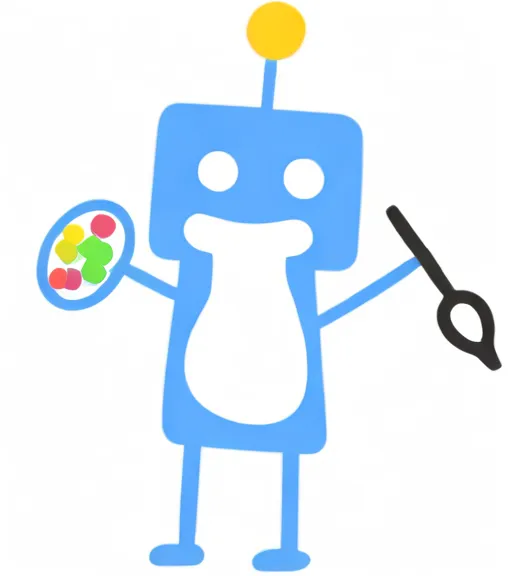
(Surface Level, by me just now)
This used to be even longer, believe it or not. A bit more personal than I thought it was going to be and there's a few sections where I mostly talk about myself - the bored reader is invited to simply skip those.
I enjoy worldbuilding. I've written probably a small novel's worth of worldbuilding Tumblr posts by now (especially if we're including Dawn of Worlds, a collaborative worldbuilding RPG that I played in 2023 and 2024). Other creative hobbies of mine include writing one-page TTRPGs, or designing custom Magic: the Gathering cards, or designing fakemons, or fangames, or whatnot. None of this is good enough to sell, nor do I need it to be. I simply enjoy working on it.
As I understand it, 'art' is increasingly synonymous with 'creative expression', so I suppose I might be a capital-A Artist, but I don't really use that term for myself. 'Creative' feels more neutral, and more honest. 'Tinkerer' captures how it feels to me, having all these pieces and trying to crystallize them into an arrangement that makes sense. That's what I named myself after - the world annealing, see?
Back on topic: I might not call myself an artist (for visual arts specifically, the picture above is as good as it gets) but I think I share a lot of the key motivators. I enjoy creating. I enjoy displays of skill. I like making something that others can use and giving it to them for free. I want to make good, useful, or interesting things, and I want them to look nice. Most of all, I want to add my own ideas to the endless conversation that humans have been having since the dawn of time.
One of my favorite authors is Alexander Wales (whose tumblr you can find here), best known for giant-sized webnovels like the 1.6 million words Worth the Candle. In a post fittingly titled The AI Art Apocalypse, he writes:
["Art is a communicative act. It’s a conversation. You see a picture and it makes you feel a certain way, and yes, sometimes you silently process that art, but most of my favorite aspects of art as discussing it with other people, wrestling with the art in public, teasing out what it’s trying to do, or what it’s doing without trying. I generally think that this is one of the best parts of being an author or an artist, this very public back and forth."]
I agree with this completely.
-----------
That was as good a bridge as any, let's talk about AI now.
A lot of the points leveraged against AI art are kind of bad. Gaming for an hour on a decent consumer PC consumes about 0.5 kWh - generating a hundred images with stable diffusion takes 0.005 kWh (other models are less transparent due to their proprietary nature, but given that it's ultimately corporations paying the power bill I don't see why electricity costs would be needlessly higher). Arguments that focus on the training data being used without permission need to contend with the fact that fully licensed generators are a reality now.
But those arguments are also not why people are against AI art in the first place. That goes back to all the subjective, intangible values I brought up in my introduction - the desire to create something personal, or interesting, or new, or inspiring, or useful. The desire to have an audience, however small. The desire for individual expression, for something other than Extruded Corporate Media Product, forever. For art that speaks and invites response - for conversation.
-----------
Creation is compromise. As I said, my real interests lie in the directions of prose writing and game design. If I was also a skilled visual artist, I could create illustrations to accompany my stories and games and 180-card custom MtG sets, and this would almost certainly improve them.
But I'm not a skilled visual artist, and I don't have infinite free time, and even if I could draw real well I think I would prefer ten hours of writing over four hours of writing and six hours of illustrating it. Nor do I have the money that would make it realistic for me to commission a hundred and eighty digital paintings. So it goes.
-----------
In Dawn of Worlds, each player takes the role of a god and helps shape the development of a world. My character was Haebarik, god of travel, a lanky red-haired giant with skin the color of slate, born from a tree on the world's first island. Distraught at the emptiness of the early world, he tore off his right arm, and cast it over the horizon, and where it landed it became the first continent. I liked this beat - it felt very mythic, not like a sanded-off modern fantasy narrative.
This was my own creation, and I am proud of it, even though it's irrevocably tainted.
See. when the game started I decided that I was going to need some kind of visual reference of my character, for the benefit of the other players if not myself. I spent some time prompting and tweaking the then-new stable diffusion, and eventually got an image I found acceptable - except that, in the wonkiness typical of such models, it'd only drawn a single arm. But seeing it, I was struck by inspiration, and in the end it made my work better.
(and to reflect the myth, the continent I drew on the map was shaped like an arm, and that shape inevitably influenced the other player's actions, and after a while I created a species that like their god only had one arm, and all of this enriched the conversation we were having and the art we were creating - or did AI poison it all?)
-----------
As I mentioned, I'm in a lot of creative spaces that aren't for visual art per se but that are often adjacent to visual art. There's a lot of people there who've clearly put a lot of effort in their craft, whose work has genuine passion and genuine personality. And sometimes I see those people reach for AI art because they've decided that illustrations would improve their work, and then they get brigaded for it.



What are we even defending here? Not beauty (it doesn't have to look good, just don't use AI), not authenticity (it doesn't have to be yours, just don't use AI), not even individual vision (it doesn't have to look like you want to, just don't use AI). It's so depressingly negative - art not defined by the presence of a human, but the absence of a machine.
More charitably, I suppose these people are asking for 'effort' or 'personality', but by what standard does a 1-minute MS paint doodle count as effortful and personal, but not The Secret Origin of Wally ManMoth? Are we guarding individual expression, or forcing it into a straitjacket?

(TSOoWM of course also doubles of a beautiful example of how DALL-E's 'overcooked plastic' look is not inherent to AI - and how someone skilled at 90% of a creative process can use it to fill in the gaps)
-----------
I'm not afraid that AI will kill art - it can't do that; nothing can. But this post's title wasn't a lie: I really do think that something awful has happened. There's an ever-sharpening divide between the communities willing to experiment with this new tool and those vehemently against it, a divide that might actually be sustainable in this age of algorithmic feeds and walled gardens.
Art is a communicative act. We are seeing the emergence of a side that would not merely cut off communication with the other, but deny they are worth listening to - deny they could speak, definitionally. If people actually started to believe that, it would betray a greater failure of imagination than any glassy-eyed slop ever could.
73 notes
·
View notes
Text
research & development is ongoing
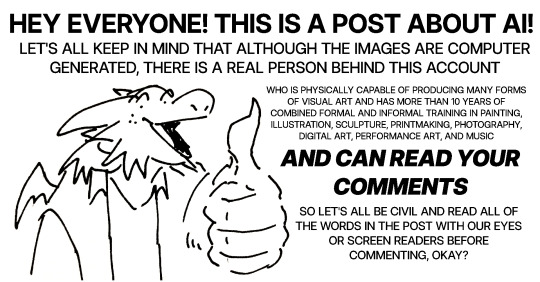
since using jukebox for sampling material on albedo, i've been increasingly interested in ethically using ai as a tool to incorporate more into my own artwork. recently i've been experimenting with "commoncanvas", a stable diffusion model trained entirely on works in the creative commons. though i do not believe legality and ethics are equivalent, this provides me peace of mind that all of the training data was used consensually through the terms of the creative commons license. here's the paper on it for those who are curious! shoutout to @reachartwork for the inspiration & her informative posts about her process!
part 1: overview
i usually post finished works, so today i want to go more in depth & document the process of experimentation with a new medium. this is going to be a long and image-heavy post, most of it will be under the cut & i'll do my best to keep all the image descriptions concise.
for a point of reference, here is a digital collage i made a few weeks ago for the album i just released (shameless self promo), using photos from wikimedia commons and a render of a 3d model i made in blender:
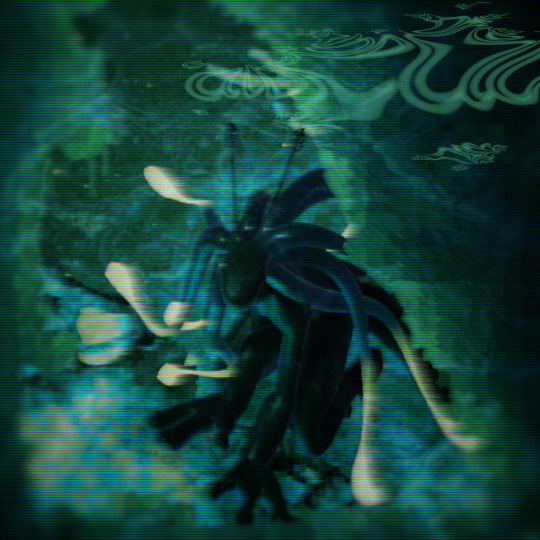
and here are two images i made with the help of common canvas (though i did a lot of editing and post-processing, more on that process in a future post):
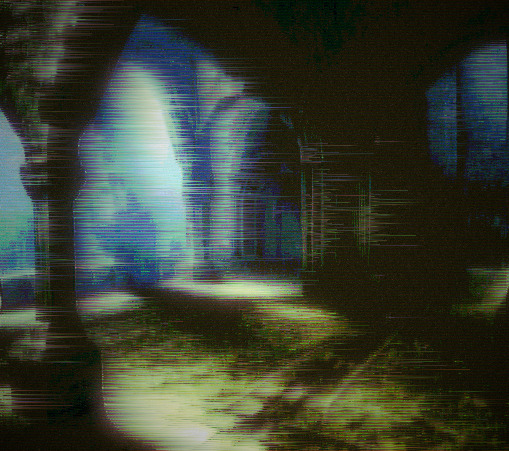

more about my process & findings under the cut, so this post doesn't get too long:
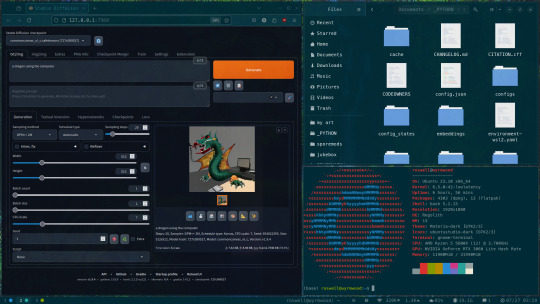
quick note for my setup: i am running this model locally on my own machine (rtx 3060, ubuntu 23.10), using the automatic1111 web ui. if you are on the same version of ubuntu as i am, note that you will probably have to build python 3.10.6 yourself (and be sure to use 'make altinstall' instead of 'make install' and change the line in the webui to use 'python3.10' instead of 'python3'. just mentioning this here because nobody else i could find had this exact problem and i had to figure it out myself)
part 2: initial exploration
all the images i'll be showing here are the raw outputs of the prompts given, with no retouching/regenerating/etc.
so: commoncanvas has 2 different types of models, the "C" and "NC" models, trained on their database of works under the CC Commercial and Non-Commercial licenses, respectively (i think the NC dataset also includes the commercial license works, but i may be wrong). the NC model is larger, but both have their unique strengths:
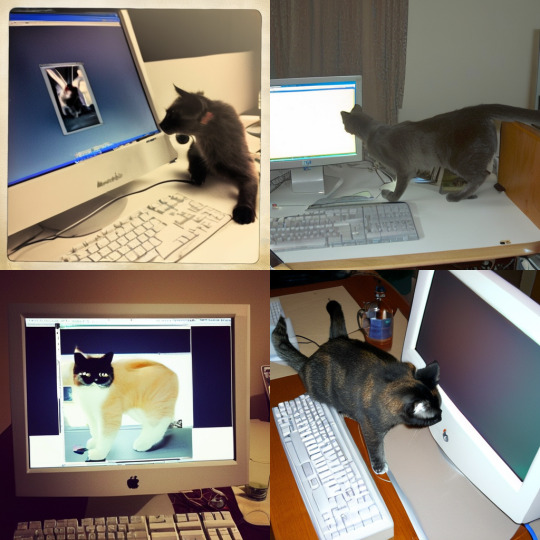
"a cat on the computer", "C" model
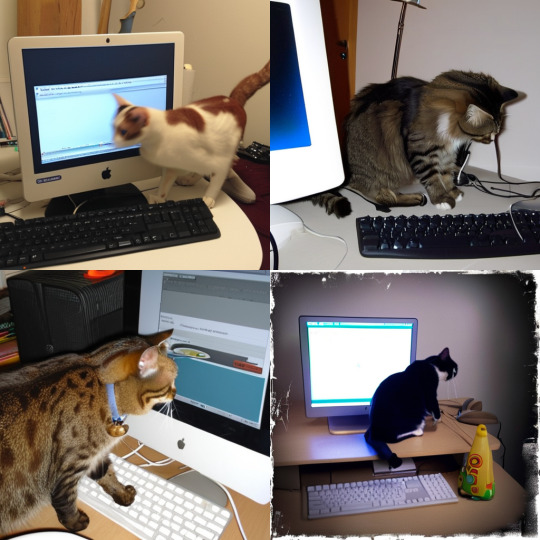
"a cat on the computer", "NC" model
they both take the same amount of time to generate (17 seconds for four 512x512 images on my 3060). if you're really looking for that early ai jank, go for the commercial model. one thing i really like about commoncanvas is that it's really good at reproducing the styles of photography i find most artistically compelling: photos taken by scientists and amateurs. (the following images will be described in the captions to avoid redundancy):
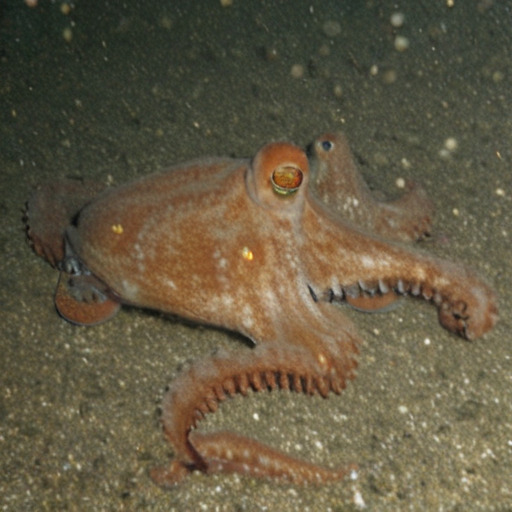
"grainy deep-sea rover photo of an octopus", "NC" model. note the motion blur on the marine snow, greenish lighting and harsh shadows here, like you see in photos taken by those rover submarines that scientists use to take photos of deep sea creatures (and less like ocean photography done for purely artistic reasons, which usually has better lighting and looks cleaner). the anatomy sucks, but the lighting and environment is perfect.
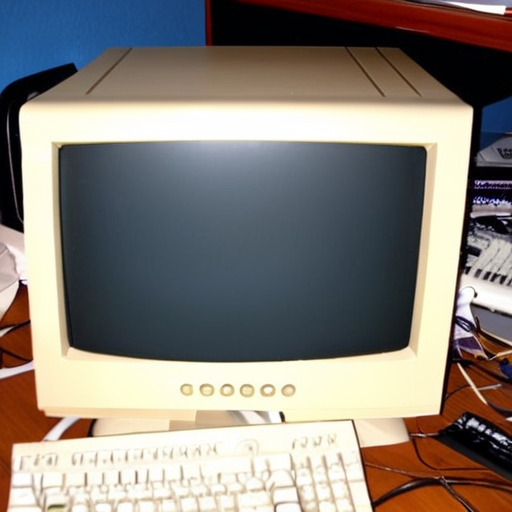
"beige computer on messy desk", "NC" model. the reflection of the flash on the screen, the reddish-brown wood, and the awkward angle and framing are all reminiscent of a photo taken by a forum user with a cheap digital camera in 2007.
so the noncommercial model is great for vernacular and scientific photography. what's the commercial model good for?
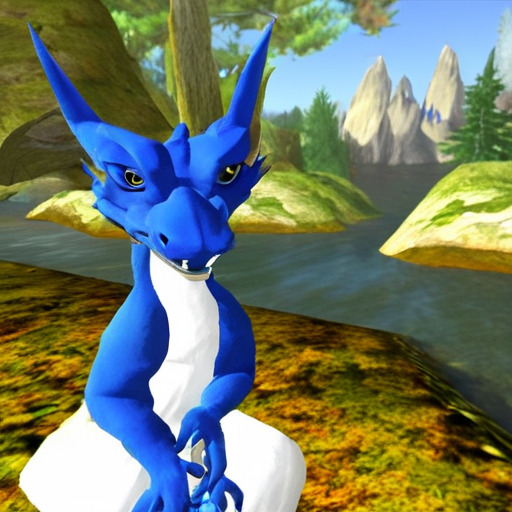
"blue dragon sitting on a stone by a river", "C" model. it's good for bad CGI dragons. whenever i request dragons of the commercial model, i either get things that look like photographs of toys/statues, or i get gamecube type CGI, and i love it.

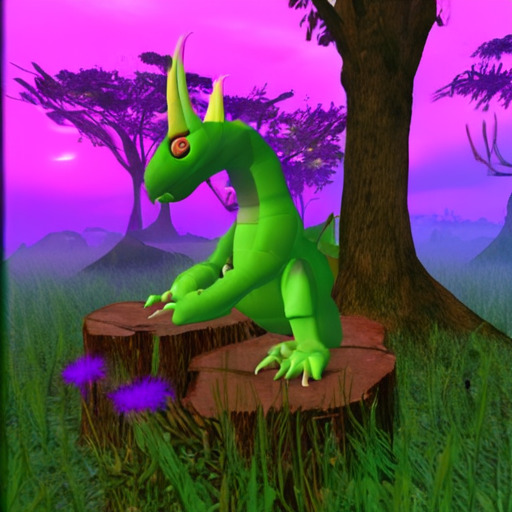
here are two little green freaks i got while trying to refine a prompt to generate my fursona. (i never succeeded, and i forget the exact prompt i used). these look like spore creations and the background looks like a bryce render. i really don't know why there's so much bad cgi in the datasets and why the model loves going for cgi specifically for dragons, but it got me thinking...
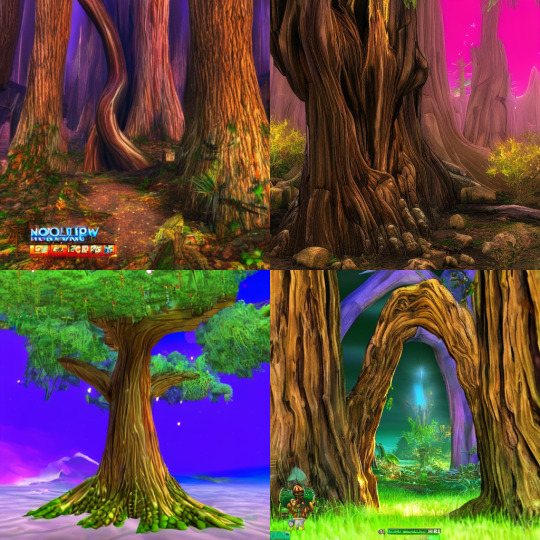
"hollow tree in a magical forest, video game screenshot", "C" model
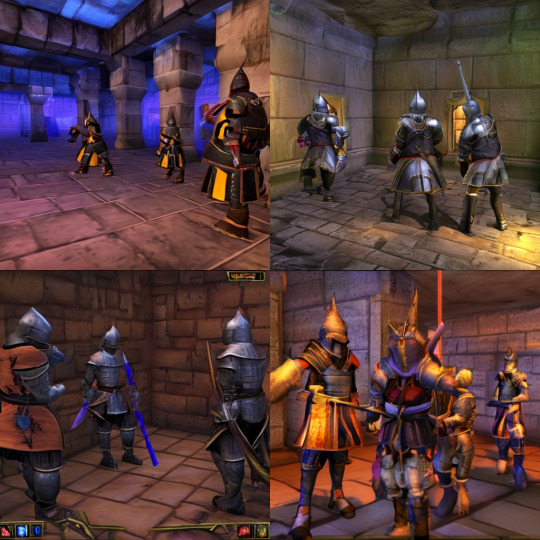
"knights in a dungeon, video game screenshot", "C" model
i love the dreamlike video game environments and strange CGI characters it produces-- it hits that specific era of video games that i grew up with super well.
part 3: use cases
if you've seen any of the visual art i've done to accompany my music projects, you know that i love making digital collages of surreal landscapes:
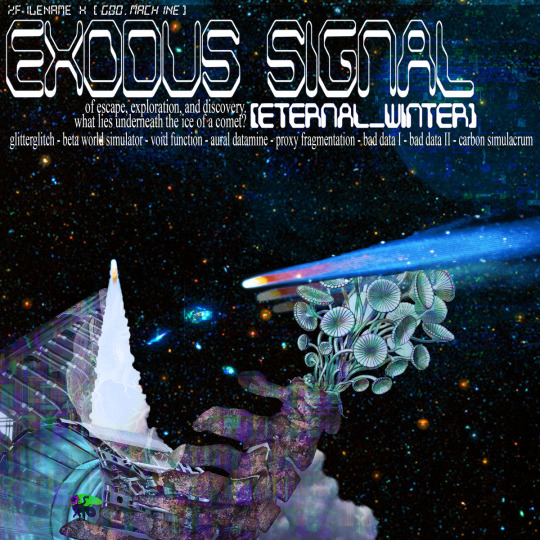
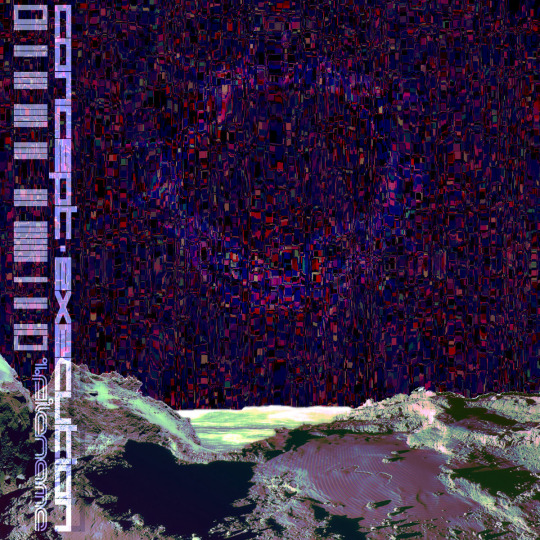
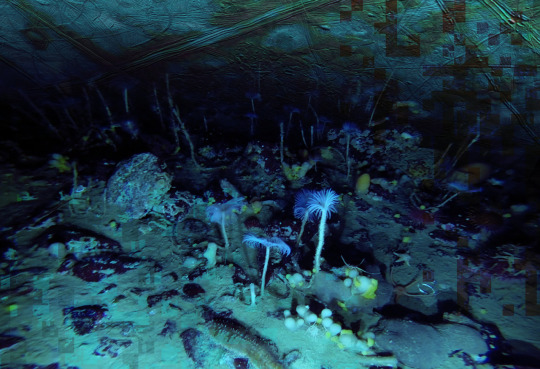
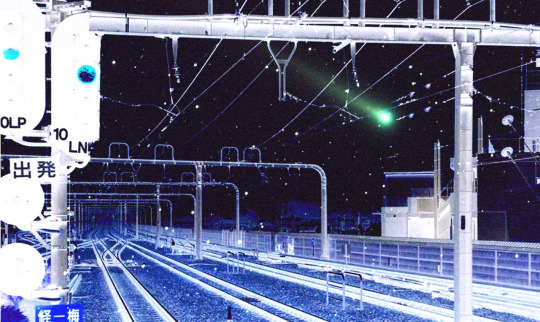
(this post is getting image heavy so i'll wrap up soon)
i'm interested in using this technology more, not as a replacement for my digital collage art, but along with it as just another tool in my toolbox. and of course...
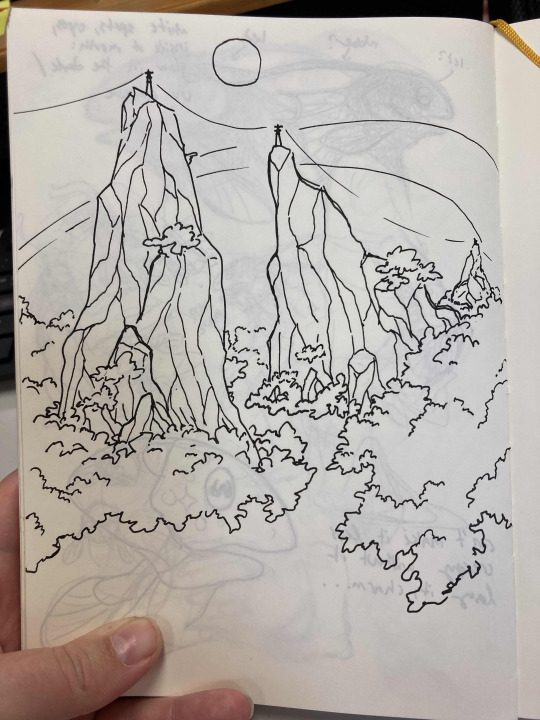
... this isn't out of lack of skill to imagine or draw scifi/fantasy landscapes.
thank you for reading such a long post! i hope you got something out of this post; i think it's a good look into the "experimentation phase" of getting into a new medium. i'm not going into my post-processing / GIMP stuff in this post because it's already so long, but let me know if you want another post going into that!
good-faith discussion and questions are encouraged but i will disable comments if you don't behave yourselves. be kind to each other and keep it P.L.U.R.
201 notes
·
View notes
Note
my apologies if you don't happen to know anything much about this, but I've been very curious as to why a lot of images from the large scale online image generation models have that yellowish tint on them lately. a lot of people are parroting the "it's inbreeding from training on all those ghibli images" talking point, which to me at least seems blatantly incorrect with a basic understanding of how these models work. but it does seem to be a real phenomenon, so how can such a thing actually happen?
correct, anyone talking about inbreeding has no idea what they're talking about. it's an artifact of the new diffusion method that chatgpt (and chatgpt alone) uses - the yellowish tint is, for once, a good indicator that something was made with chatgpt because nothing else produces it. people also theorize its a deliberate filter put in by openai but we dont have any way of proving that so.
47 notes
·
View notes
Text
Blocking the “inzoi” tag.
I’ve done my research, though I’d like to do more, specifically on what their models were trained on, and electricity usage locally.
Keep in mind that: Though their AI is generating textures and models based on local and user-input, afaik it’s using stable diffusion, which was trained with stolen material. As I sit here typing on an iPhone that probably has a supply chain that would make Nestle blush, I have to wonder just how much I want to pick and choose in my complicity, and how much I want to scream at others over it. (There are more productive ways to have this conversation and a little self awareness doesn’t hurt, is what I’m saying.)
Regarding sources:
SustainabilityByNumbers has a good breakdown of AI and data center energy usage and includes a comparison to other industries. (Generation is far less costly than training.)
Carbon Emissions on Writing and Illustrating outlines the emissions for those things with AI vs humans.
How much does rendering at home cost? (Renderstreet) A serious look at the cost of non-AI rendering.
However. H o w e v e r.
It’s articles like this (Inzoi’s use of AI on TheGamer.com) that ultimately have swayed me toward not buying the game.
Setting aside the grey area of locally-generated, user-based material and its costs vs non-AI rendering and modding, we need to consider what we are condoning and supporting when purchasing a game like this. We do not need to be telling the industry that a flagship for in-game AI tools is OK—especially when it was created by a company that is on the forefront of using that tech to the active detriment of so many careers.
The above article does a good job summarizing Krafton’s shady practices with its other investments; suffice to say that this is about boycotting a company who would rather use AI, even if it’s supposedly “”ethical””, than support game developers, who are already actively used and abused by the video game industry (which we are supporting by buying things like the Sims, Dragon Age, etc).
For me at least, it’s also about how much I want to support the shitty techno-feudalistic, zombie capitalism that companies like Krafton and others continue to get away with. The only good thing I can say about Krafton is that, unlike most of the big gaming companies, they’re wearing this use of AI on their sleeve. If you think no AI is being used in other game studios, you are sadly mistaken.
Until companies can show they’ll be flexible in maintaining healthy, safe employment for people, without the massive layoffs the gaming industry is so infamous for, I’m just not signing off on this.
I’m well aware that using Blender, playing video games, owning an iPhone, or a car, or taking public transit, still makes me complicit. I think people forget that they are just as complicit when harassing and sending threats to people who are playing InZoi. I’m not any better of a person for not buying and not playing it. It’s just not something in which I will personally take part.
I’m not going to harass anyone— I can’t stop y’all from doing what you want to do. If you play it, then… you’re playing it. You’re not a worse person for doing so.
I just want nothing to do with it and that’s that.
45 notes
·
View notes
Text
We need to talk about AI
Okay, several people asked me to post about this, so I guess I am going to post about this. Or to say it differently: Hey, for once I am posting about the stuff I am actually doing for university. Woohoo!
Because here is the issue. We are kinda suffering a death of nuance right now, when it comes to the topic of AI.
I understand why this happening (basically everyone wanting to market anything is calling it AI even though it is often a thousand different things) but it is a problem.
So, let's talk about "AI", that isn't actually intelligent, what the term means right now, what it is, what it isn't, and why it is not always bad. I am trying to be short, alright?

So, right now when anyone says they are using AI they mean, that they are using a program that functions based on what computer nerds call "a neural network" through a process called "deep learning" or "machine learning" (yes, those terms mean slightly different things, but frankly, you really do not need to know the details).
Now, the theory for this has been around since the 1940s! The idea had always been to create calculation nodes that mirror the way neurons in the human brain work. That looks kinda like this:

Basically, there are input nodes, in which you put some data, those do some transformations that kinda depend on the kind of thing you want to train it for and in the end a number comes out, that the program than "remembers". I could explain the details, but your eyes would glaze over the same way everyone's eyes glaze over in this class I have on this on every Friday afternoon.
All you need to know: You put in some sort of data (that can be text, math, pictures, audio, whatever), the computer does magic math, and then it gets a number that has a meaning to it.
And we actually have been using this sinde the 80s in some way. If any Digimon fans are here: there is a reason the digital world in Digimon Tamers was created in Stanford in the 80s. This was studied there.
But if it was around so long, why am I hearing so much about it now?
This is a good question hypothetical reader. The very short answer is: some super-nerds found a way to make this work way, way better in 2012, and from that work (which was then called Deep Learning in Artifical Neural Networks, short ANN) we got basically everything that TechBros will not shut up about for the last like ten years. Including "AI".
Now, most things you think about when you hear "AI" is some form of generative AI. Usually it will use some form of a LLM, a Large Language Model to process text, and a method called Stable Diffusion to create visuals. (Tbh, I have no clue what method audio generation uses, as the only audio AI I have so far looked into was based on wolf howls.)
LLMs were like this big, big break through, because they actually appear to comprehend natural language. They don't, of coruse, as to them words and phrases are just stastical variables. Scientists call them also "stochastic parrots". But of course our dumb human brains love to anthropogice shit. So they go: "It makes human words. It gotta be human!"
It is a whole thing.
It does not understand or grasp language. But the mathematics behind it will basically create a statistical analysis of all the words and then create a likely answer.

What you have to understand however is, that LLMs and Stable Diffusion are just a a tiny, minority type of use cases for ANNs. Because research right now is starting to use ANNs for EVERYTHING. Some also partially using Stable Diffusion and LLMs, but not to take away people'S jobs.
Which is probably the place where I will share what I have been doing recently with AI.
The stuff I am doing with Neural Networks
The neat thing: if a Neural Network is Open Source, it is surprisingly easy to work with it. Last year when I started with this I was so intimidated, but frankly, I will confidently say now: As someone who has been working with computers for like more than 10 years, this is easier programming than most shit I did to organize data bases. So, during this last year I did three things with AI. One for a university research project, one for my work, and one because I find it interesting.
The university research project trained an AI to watch video live streams of our biology department's fish tanks, analyse the behavior of the fish and notify someone if a fish showed signs of being sick. We used an AI named "YOLO" for this, that is very good at analyzing pictures, though the base framework did not know anything about stuff that lived not on land. So we needed to teach it what a fish was, how to analyze videos (as the base framework only can look at single pictures) and then we needed to teach it how fish were supposed to behave. We still managed to get that whole thing working in about 5 months. So... Yeah. But nobody can watch hundreds of fish all the time, so without this, those fish will just die if something is wrong.
The second is for my work. For this I used a really old Neural Network Framework called tesseract. This was developed by Google ages ago. And I mean ages. This is one of those neural network based on 1980s research, simply doing OCR. OCR being "optical character recognition". Aka: if you give it a picture of writing, it can read that writing. My work has the issue, that we have tons and tons of old paper work that has been scanned and needs to be digitized into a database. But everyone who was hired to do this manually found this mindnumbing. Just imagine doing this all day: take a contract, look up certain data, fill it into a table, put the contract away, take the next contract and do the same. Thousands of contracts, 8 hours a day. Nobody wants to do that. Our company has been using another OCR software for this. But that one was super expensive. So I was asked if I could built something to do that. So I did. And this was so ridiculously easy, it took me three weeks. And it actually has a higher successrate than the expensive software before.
Lastly there is the one I am doing right now, and this one is a bit more complex. See: we have tons and tons of historical shit, that never has been translated. Be it papyri, stone tablets, letters, manuscripts, whatever. And right now I used tesseract which by now is open source to develop it further to allow it to read handwritten stuff and completely different letters than what it knows so far. I plan to hook it up, once it can reliably do the OCR, to a LLM to then translate those texts. Because here is the thing: these things have not been translated because there is just not enough people speaking those old languages. Which leads to people going like: "GASP! We found this super important document that actually shows things from the anceint world we wanted to know forever, and it was lying in our collection collecting dust for 90 years!" I am not the only person who has this idea, and yeah, I just hope maybe we can in the next few years get something going to help historians and archeologists to do their work.

Make no mistake: ANNs are saving lives right now
Here is the thing: ANNs are Deep Learning are saving lives right now. I really cannot stress enough how quickly this technology has become incredibly important in fields like biology and medicine to analyze data and predict outcomes in a way that a human just never would be capable of.
I saw a post yesterday saying "AI" can never be a part of Solarpunk. I heavily will disagree on that. Solarpunk for example would need the help of AI for a lot of stuff, as it can help us deal with ecological things, might be able to predict weather in ways we are not capable of, will help with medicine, with plants and so many other things.
ANNs are a good thing in general. And yes, they might also be used for some just fun things in general.
And for things that we may not need to know, but that would be fun to know. Like, I mentioned above: the only audio research I read through was based on wolf howls. Basically there is a group of researchers trying to understand wolves and they are using AI to analyze the howling and grunting and find patterns in there which humans are not capable of due ot human bias. So maybe AI will hlep us understand some animals at some point.
Heck, we saw so far, that some LLMs have been capable of on their on extrapolating from being taught one version of a language to just automatically understand another version of it. Like going from modern English to old English and such. Which is why some researchers wonder, if it might actually be able to understand languages that were never deciphered.
All of that is interesting and fascinating.
Again, the generative stuff is a very, very minute part of what AI is being used for.

Yeah, but WHAT ABOUT the generative stuff?
So, let's talk about the generative stuff. Because I kinda hate it, but I also understand that there is a big issue.
If you know me, you know how much I freaking love the creative industry. If I had more money, I would just throw it all at all those amazing creative people online. I mean, fuck! I adore y'all!
And I do think that basically art fully created by AI is lacking the human "heart" - or to phrase it more artistically: it is lacking the chemical inbalances that make a human human lol. Same goes for writing. After all, an AI is actually incapable of actually creating a complex plot and all of that. And even if we managed to train it to do it, I don't think it should.
AI saving lives = good.
AI doing the shit humans actually evolved to do = bad.
And I also think that people who just do the "AI Art/Writing" shit are lazy and need to just put in work to learn the skill. Meh.
However...
I do think that these forms of AI can have a place in the creative process. There are people creating works of art that use some assets created with genAI but still putting in hours and hours of work on their own. And given that collages are legal to create - I do not see how this is meaningfully different. If you can take someone else's artwork as part of a collage legally, you can also take some art created by AI trained on someone else's art legally for the collage.
And then there is also the thing... Look, right now there is a lot of crunch in a lot of creative industries, and a lot of the work is not the fun creative kind, but the annoying creative kind that nobody actually enjoys and still eats hours and hours before deadlines. Swen the Man (the Larian boss) spoke about that recently: how mocapping often created some artifacts where the computer stuff used to record it (which already is done partially by an algorithm) gets janky. So far this was cleaned up by humans, and it is shitty brain numbing work most people hate. You can train AI to do this.
And I am going to assume that in normal 2D animation there is also more than enough clean up steps and such that nobody actually likes to do and that can just help to prevent crunch. Same goes for like those overworked souls doing movie VFX, who have worked 80 hour weeks for the last 5 years. In movie VFX we just do not have enough workers. This is a fact. So, yeah, if we can help those people out: great.
If this is all directed by a human vision and just helping out to make certain processes easier? It is fine.
However, something that is just 100% AI? That is dumb and sucks. And it sucks even more that people's fanart, fanfics, and also commercial work online got stolen for it.
And yet... Yeah, I am sorry, I am afraid I have to join the camp of: "I am afraid criminalizing taking the training data is a really bad idea." Because yeah... It is fucking shitty how Facebook, Microsoft, Google, OpenAI and whatever are using this stolen data to create programs to make themselves richer and what not, while not even making their models open source. BUT... If we outlawed it, the only people being capable of even creating such algorithms that absolutely can help in some processes would be big media corporations that already own a ton of data for training (so basically Disney, Warner and Universal) who would then get a monopoly. And that would actually be a bad thing. So, like... both variations suck. There is no good solution, I am afraid.
And mind you, Disney, Warner, and Universal would still not pay their artists for it. lol
However, that does not mean, you should not bully the companies who are using this stolen data right now without making their models open source! And also please, please bully Hasbro and Riot and whoever for using AI Art in their merchandise. Bully them hard. They have a lot of money and they deserve to be bullied!

But yeah. Generally speaking: Please, please, as I will always say... inform yourself on these topics. Do not hate on stuff without understanding what it actually is. Most topics in life are nuanced. Not all. But many.
#computer science#artifical intelligence#neural network#artifical neural network#ann#deep learning#ai#large language model#science#research#nuance#explanation#opinion#text post#ai explained#solarpunk#cyberpunk
27 notes
·
View notes
Text
Developing new drugs to treat illnesses has typically been a slow and expensive process. However, a team of researchers at the University of Waterloo uses machine learning to speed up the development time. The Waterloo research team has created Imagand, a generative artificial intelligence model that assesses existing information about potential drugs and then suggests their potential properties. Trained on and tested against existing drug data, Imagand successfully predicts important properties of different drugs that have already been independently verified in lab studies, demonstrating the AI's accuracy. The research, titled "Drug discovery SMILES-to-pharmacokinetics diffusion models with deep molecular understanding," is currently available on the arXiv preprint server.
Continue Reading.
31 notes
·
View notes